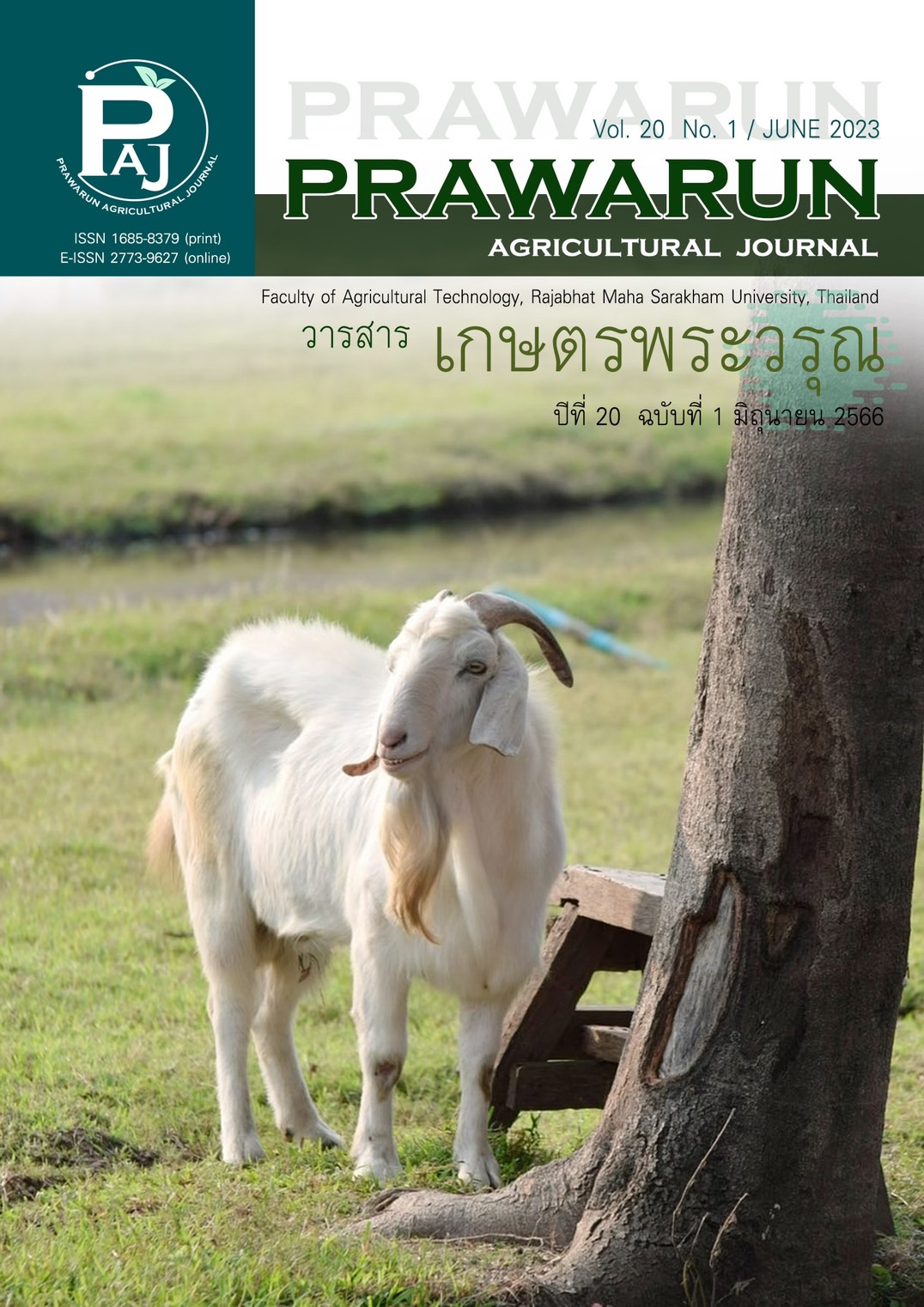ศักยภาพของสารสกัดกัญชาที่ยับยั้งเชื้อที่ก่อโรคในสัตว์
Main Article Content
บทคัดย่อ
งานวิจัยนี้มีจุดประสงค์ในการหาฤทธิ์ของสารสกัดกัญชาสองสายพันธุ์ (สายพันธุ์ฝอยทองภูผายลและสายพันธุ์หางกระรอกร้อยเอ็ด) ในการต้านจุลชีพก่อโรคชนิดต่าง ๆ ได้แก่ แบคทีเรียก่อโรคเต้านมอักเสบในโคนมจำนวน 9 สายพันธุ์ และยีสต์และเชื้อราที่ก่อโรคผิวหนังและระบบทางเดินหายใจจากสัตว์ที่เป็นโรค สารสกัดหยาบจากใบกัญชาได้มาจากการสกัดโดยตัวทำละลายชนิดต่าง ๆ ได้แก่ เอทานอล เมธานอล อะซีโตน และคลอโรฟอร์ม ทำการทดสอบการออกฤทธิ์ของสารสกัดในการต้านจุลชีพต่าง ๆ ด้วยวิธี Disc diffusion และหาความเข้มข้นของสารสกัดที่น้อยที่สุดในการต้านจุลชีพ (Minimum inhibition concentration, MIC) และความเข้มข้นของสารสกัดที่น้อยที่สุดในการฆ่าจุลชีพ (Minimum bacteriocidal/Fungicidal concentration, MBC/MFC) ด้วยวิธี Microbroth dilution สารสกัดหยาบโดยใช้เมทานอลเป็นตัวทำละลายมีประสิทธิภาพในวงกว้างในการยับยั้งแบคทีเรียก่อโรคเต้านมอับเสบในโคนมทดสอบ ได้แก่ กลุ่มแบคทีเรีย แกรมบวกสามสายพันธุ์: Staphylococcus aureus A0527, Staphylococcus haemolyticus A12321 และ Staphylococcus pneumonia 001.12, และกลุ่มแบคทีเรียแกรมลบ: Pseudomonas aeruginosa A11015, Mycoplasma pneumoniae 001.1, Klebsiella pneumoniae 001.3 และ Escherichia coli A24622 ที่ค่า MIC 50 ไมโครกรัมต่อมิลลิตร และ MBC 400 ไมโครกรัมต่อมิลลิตร ยกเว้นแบคทีเรีย Staphylococcus faecalis 001.9 ที่ทนทานต่อการยับยั้ง นอกจากนี้สารสกัดหยาบที่ใช้เมทานอลเป็นตัวทำละลายยังสามารถยับยั้งและฆ่ายีสต์และเชื้อราก่อโรคผิวหนังได้แก่ Candida albican, Malassizia pachydermatis และ Trichophyton sp. รวมถึงยีสต์ก่อโรคในระบบทางเดินหายใจในสัตว์ Cryptococcus neoformans ได้ ที่ค่า MIC 50 ไมโครกรัมต่อมิลลิตร และค่า MBC 400 ไมโครกรัมต่อมิลลิตร แสดงให้เห็นว่าสารสกัดใบกัญชามีประสิทธิภาพในการยับยั้งเชื้อก่อโรคในสัตว์ จึงควรส่งเสริมมาผลิตยาใช้ในการรักษาโรคที่เกิดจากเชื้อจุลินทรีย์ในทางคลินิกและมีความเป็นไปได้ในการนำไปพัฒนาเป็นยารักษาโรคผิวหนังสำหรับสัตว์อีกหลายชนิด
Article Details
เอกสารอ้างอิง
Abdullah Sani, N., Sawei, J., Ratnam, W., & Abdul Rahman, Z. (2018). Physical, antioxidant and antibacterial properties of rice (Oryza sativa L.) and glutinous rice (Oryza sativa var. glutinosa) from local cultivators and markets of Peninsular, Malaysia. International Food Research Journal, 25(6), 2328-2336.
Anjum, M., Arooj, Z. E., Azam, S., Rehman, P., & Khadim, J. (2018). Evaluation of antimicrobial activity and ethnobotanical study of Cannabis sativa L.Pure and Applied Biology, 7(2),706-713.
Appendino, G., Gibbons, S., Giana, A., Pagani, A., Grassi, G., Stavri, M., Smith, E., & Rahman, M. M. (2008). Antibacterial Cannabinoids from Cannabis sativa: a structure−activity study.Journal of Natural Products, 71(8), 1427–1430. doi: 10.1021/np8002673
Arsheewa, W. (2016). Prevalence of carbapenemase enzyme in clinical isolates of carbapenem-resistant Enterobacteriaceae from Prapokklao Hospital in 2012 – 2013. The Journal of Prapokklao Hospital Clinical Medical Education Center, 33(4), 314-325. (in Thai)
Blaskovich, M. A. T., Kavanagh, A. G., Elliott, A. G., Zhang, B., Ramu, S., Amado, M., Lowe, G. J., Hinton, A. O., Pham, D. M. T., Zuegg, J., Beare, N., Quach, D., Sharp, M. D., Pogliano, J., Rogers, A. P., Lyras, D., Tan, L., West, N. P., Crawford, D. W., Peterson, M. L., Callahan, M., & Thurn, M. (2021).The antimicrobial potential of cannabidiol. Communications Biology, 4(1), 7. doi: 10.1038/s42003-020-01530-y
Chakraborty, S., Afaq, N., Singh, N., & Majumdar, S. (2018). Antimicrobial activity of Cannabis sativa, Thuja orientalis and Psidium guajava leaf extracts against methicillin-resistant Staphylococcus aureus. Journal of Integrative Medicine, 16(5), 350-357. doi: 10.1016/j.joim.2018.07.005
Farha, M. A., El-Halfawy, O. M., Gale, R. T., MacNair, C. R., Carfrae, L. A., Zhang, X., Jentsch, N. G., Magolan, J., & Brown, E.D.(2020).Uncovering the hidden antibiotic potential of Cannabis. American Chemical Society Infectious diseases, 6(3), 338-346. doi: 10.1021/acsinfecdis.9b00419
Frassinetti, S., Gabriele, M., Moccia, E., Longo, V., & Gioia, D. D. (2020). Antimicrobial and antibiofilm activity of Cannabis sativa L. seeds extract against Staphylococcus aureus and growth effects on probiotic Lactobacillus spp. LWT-Food Science and Technology, 124(5), 109149. doi:10.1016/j.lwt.2020.109149
Gwinn, K. D., Hansen, Z., Kelly, H. , & Ownley, H. B. (2022). Diseases of Cannabis sativa caused by diverse Fusarium species. Frontiers in Agronomy, 3, 796062. doi: 10.3389/fagro.2021.796062
Galletta, M., Reekie, T. A., Nagalingam, G., Bottomley A. L., Harry, E. J., Kassiou, M., & Triccas, J. A. (2020). Rapid antibacterial activity of cannabichromenic acid against methicillin-resistant Staphylococcus aureus. Antibiotics, 9(8), 523. doi: 10.3390/antibiotics9080523
Isahq, M. S, Afridi, M. S., Ali, J., Hussain, M. M., Ahmad, S., & Kanwal, F. (2015). Proximate composition, phytochemical screening, GC-MS studies of biologically active cannabinoids and antimicrobial activities of Cannabis indica. Asian Pacific Journal of Tropical Disease, 5(11), 897–902. doi: 10.1016/s2222-1808(15)60953-7
Khan, I. H., & Javaid, A. (2020). Antifungal activity of leaf extract of Cannabis sativa against Aspergillus flavipes. Pakistan Journal of Weed Science Research, 26(4), 447-453. doi: 10.28941/pjwsr.v26i4.883
Karas, J. A., Wong, L. J. M., Paulin, O. K. A., Mazeh, A. C., Hussein, M. H., Li, J., & Velkov, T. (2020). The antimicrobial activity of cannabinoids. Antibiotics, 9 (7), 406. doi: 10.3390/antibiotics9070406
Martinenghi, L. D., Jonsson, R., Lund, T., & Jenssen, H. (2020). Isolation, purification, and antimicrobial characterization of cannabidiolic acid and cannabidiol from Cannabis sativa L. Biomolecules, 10(6), 900. doi: 10.3390/biom10060900
National Antimicrobial Resistance Surveillance Center, Thailand. (2022). Thailand’s integrate antimicrobial resistance surveillance with one health approach guideline. Accessed March 11, 2023. Retrieved from http://narst.dmsc.moph.go.th/. (in Thai)
Nadir, I., Rana, N. F., Ahmad, N. M., Tanweer, T., Batool, A., Taimoor, Z., Riaz, S., & Ali, S. M. (2020). Cannabinoids and terpenes as an antibacterial and antibiofouling promotor for PES water filtration membranes. Molecules, 25(3)), 691. doi: 10.3390/molecules25030691
Nalli, Y., Arora, P., Hassan, S. R. U., & Ali, A. (2018). Chemical investigation of Cannabis sativa leading to the discovery of a prenylspirodinone with anti-microbial potential. Tetrahedron Letters, 59(25), 2470-2472.
Oliver., S. P. (2004). Microbiological procedures for the diagnosis of bovine udder infection and determination of milk quality (4th ed. ). Wisconsin: National Mastitis Council (NMC).
Schofs, L., Sparo, M. D., & Bruni, S. F. S. (2021). The antimicrobial effect behind Cannabis sativa. Pharmacology Research and Perspectives, 9(2), e00761. doi: 10.1002/prp2.761
Sharma, A., Gupta, V. K., & Pathania, R. (2019).Efflux pump inhibitors for bacterial pathogens: From bench to bedside. Indian Journal of Medical Research, 149(2), 129-145. doi: 10.4103/ijmr.IJMR_2079_17
Singh, P., Pandit, S., Garnæs, J., Tunjic, S., Mokkapati, V. R., Sultan, A., Thygesen, A., Mackevica, A., Mateiu, R. V., Daugaard, A. E., Baun, A., & Mijakovic, I. (2018). Green synthesis of gold and silver nanoparticles from Cannabis sativa industrial hemp) and their capacity for biofilm inhibition. International Journal of Nanomedicine, 13, 3571-3591. doi: 10.2147/IJN.S157958
Swain, S., Barik, S. K., Behera, T., Nayak, S. K., Sahoo, S. K., Mishra, S. S., & Swain, P. (2016). Green synthesis of gold nanoparticles using root and leaf extracts of Vetiveria zizanioides and Cannabis sativa and its antifungal activities.BioNanoScience, 6,(3)205-213. doi: 10.1007/s12668-016-0208-y


